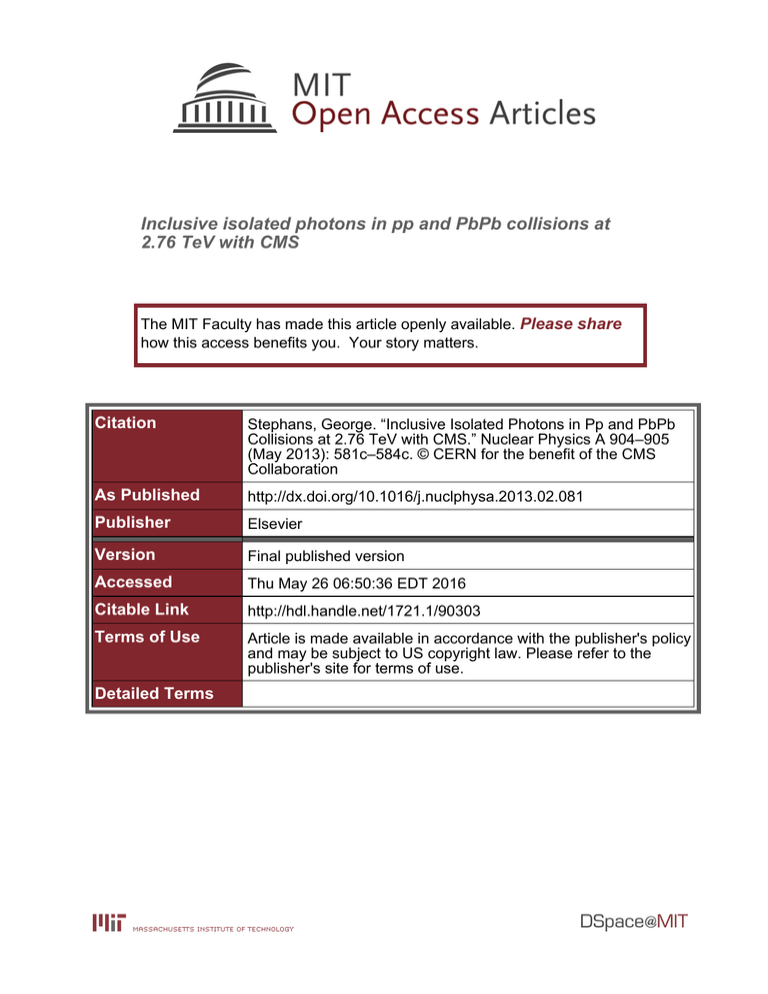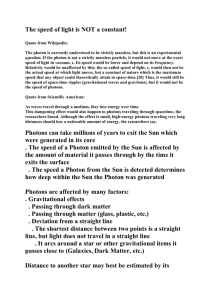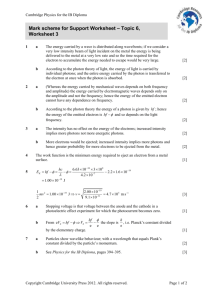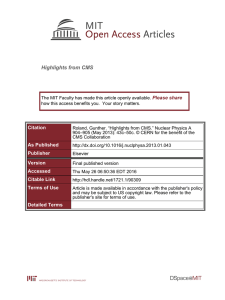Inclusive isolated photons in pp and PbPb collisions at Please share
advertisement

Inclusive isolated photons in pp and PbPb collisions at 2.76 TeV with CMS The MIT Faculty has made this article openly available. Please share how this access benefits you. Your story matters. Citation Stephans, George. “Inclusive Isolated Photons in Pp and PbPb Collisions at 2.76 TeV with CMS.” Nuclear Physics A 904–905 (May 2013): 581c–584c. © CERN for the benefit of the CMS Collaboration As Published http://dx.doi.org/10.1016/j.nuclphysa.2013.02.081 Publisher Elsevier Version Final published version Accessed Thu May 26 06:50:36 EDT 2016 Citable Link http://hdl.handle.net/1721.1/90303 Terms of Use Article is made available in accordance with the publisher's policy and may be subject to US copyright law. Please refer to the publisher's site for terms of use. Detailed Terms Available online at www.sciencedirect.com Nuclear Physics A 904–905 (2013) 581c–584c www.elsevier.com/locate/nuclphysa Inclusive isolated photons in pp and PbPb collisions at 2.76 TeV with CMS George Stephans (for the CMS Collaboration)1 Massachusetts Institute of Technology, Cambridge, MA, USA Abstract The CMS detector at the LHC has been used to measure the yield of isolated photons in both proton-proton and lead-lead collisions at a nucleon-nucleon center of mass energy of 2.76 TeV. Photons were detected in the pseudorapidity range |η| < 1.44 and with transverse energies ET between 20 and 80 GeV. The ET spectra found using next-to-leading-order perturbative QCD calculations are in good agreement with the data. The centrality dependence of the ratio of isolated photon yields in PbPb over those in pp is well described by the number of incoherent nucleon-nucleon collisions. Therefore, the yields of isolated photons in PbPb are consistent with there being no modification of their production in the initial state and no absorption of these photons as they traverse the hot and dense medium created in these very high energy heavy ion collisions. 1. Introduction In July of 2012, the CMS Collaboration announced√the discovery of a new boson with a mass of about 125 GeV in proton-proton (pp) collisions at s=7 and 8 TeV [1] at the LHC. Photons observed in the CMS detector provided the most significant evidence for this new particle. Similar results, also heavily dependent on photon data, were found by the ATLAS experiment [2]. Although definitive proof will require additional analysis and higher integrated pp luminosity, it is widely believed that this new particles is the long-sought Higgs boson, first proposed nearly 50 years ago [3, 4, 5, 6]. If so, study of photons using the CMS detector will help elucidate the origin of mass for fundamental subatomic particles such as leptons and quarks. However, the Higgs mechanism is responsible for only a few percent of the mass of the particles of which normal matter is comprised. Instead, the mass of these protons and neutrons, as well as that of almost all composite particles such as hadrons, results from the binding energy of the strong interaction, as described by Quantum Chromo Dynamics (QCD). Although QCD is well defined quantitatively at high momentum transfer, detailed understanding of the full range of possible QCD interactions is still a topic of active theoretical work. Photons detected by the CMS experiment can help to elucidate the nature of this alternative source of mass as well. Specifically, photons can be used to probe the hot and dense QCD matter produced in high energy lead-lead (PbPb) collisions at the LHC. 1A list of members of the CMS Collaboration and acknowledgements can be found at the end of this issue. © CERN for the benefit of the CMS Collaboration. 0375-9474/ © 2013 CERN Published by Elsevier B.V. All rights reserved. http://dx.doi.org/10.1016/j.nuclphysa.2013.02.081 582c G. Stephans / Nuclear Physics A 904–905 (2013) 581c–584c This proceedings presents results for the transverse energy and centrality dependence of iso√ lated proton yield in pp and PbPb collisions at sNN =2.76 TeV. Using pp data at the same center of mass energy as a baseline for comparison, the photon data from the PbPb interactions are used to test two hypotheses. The first is whether the spectra of photons can be accurately predicted by next-to-leading-order perturbative QCD calculations using parton distribution functions (PDFs) modified for the lead nucleus environment. The second is whether the centrality dependence of the photon yield can be modeled as a sum of pp interactions, where the centrality dependence of the number of interactions is determined by a Glauber model. If both hypotheses are confirmed, the conclusion would be that there is no modification of the initial isolated photon production and no absorption of the outgoing photons. Full details of this measurement have already been published [7] and, therefore, this paper gives only a brief summary of the analysis and results. 2. Data and Analysis The data samples used in this analysis include integrated luminosities of 231 nb−1 and 6.8 √ μb for pp and PbPb collisions, respectively, both at sNN =2.76 TeV. Photons were detected in the pseudorapidity range |η| < 1.44 using the barrel segment of the CMS electromagnetic calorimeter (ECAL) detector which is very finely segmented in η and φ (0.0174 × 0.0174). The hadronic calorimeter (HCAL) is also used to separate out background as described below. A forward hadronic calorimeter (HF) subtending 3 < |η| < 5.2 was used for centrality determination in the PbPb collisions. Full details of the CMS detector can be found in Ref. [8]. Photons are found from the ECAL data by forming superclusters of the energies deposited in individual modules. Electrons are rejected by matching the resulting photon candidates with charged particles found using the silicon tracker. In order to perform the comparisons discussed previously, it is necessary to separate out direct photons from those produced by other processes, including fragmentation and resonance decay, which are responsible for the bulk of the photons emitted in these collisions. The primary experimental separation technique is to select “isolated” photons, those with very little observed energy in a cone surrounding the photon direction. Limits on the observed energies in both the ECAL and HCAL are used in the isolation test. The remaining background is separated on a statistical basis by modeling how the energy within a supercluster is distributed in η. Using a combination of theory and data, it is found that the shape of this distribution is significantly different for direct and non-direct photons and, therefore, a fit to the data using a sum of the two distributions can be used to extract the direct fraction. −1 3. Results The results on isolated photon production used to address the two hypotheses tested using isolated photon data are shown in Fig. 1. The left panel of Fig. 1 shows the transverse energy spectra extracted for both pp and PbPb (with the latter shown for both minimum bias and also divided into three centrality classes). The various PbPb results are each divided by the nuclear overlap function T AA which is found by dividing the number of nucleon-nucleon (NN) collisions, found from a Glauber model [9] for the particular centrality range, by the pp inelastic cross section. This is effectively the NN-equivalent integrated luminosity for each PbPb centrality. Also shown is the result of a JETPHOX calculation (version 1.2.2) [10] using the CT10 PDF [11]. G. Stephans / Nuclear Physics A 904–905 (2013) 581c–584c 583c Figure 1: (Left) Normalized isolated photon yields (dN γ /dET )/T AA as a function of photon ET in 0-10%, 10-30%, √ 30-100% and MinBias PbPb collisions at sNN = 2.76 TeV. The results are compared with the pp prediction using JETPHOX at this center-of-mass energy, with its scale uncertainty. (Right) Nuclear modification factor RAA as a function √ of the photon ET measured in 0-10% central PbPb collisions over the T AA -scaled pp JETPHOX prediction at sNN = 2.76 TeV. The vertical error bars indicate the statistical uncertainty and the horizontal bars reflect the bin width. The total systematic uncertainties without the T AA uncertainty are shown as yellow filled boxes. The T AA uncertainty, common to all points, is indicated by the grey box centered at unity. The curves show the theoretical predictions, obtained with JETPHOX for various nuclear PDFs. The uncertainty from the EPS09 PDF parameters is shown as the red dashed lines. Both figures are taken from Ref. [7]. It is clear that this calculation does a good job of reproducing both the pp and the T AA scaled PbPb results. No evidence for any modification of the photon production, either in the overall yield or in the transverse energy distribution, is found. Possible modification of the photon yields is explored in more detail in the right panel of Fig. 1 which shows the nuclear modification factor (RAA ) as a function of photon transverse energy for one PbPb centrality bin. The value of RAA is found by dividing the T AA scaled differential yield in PbPb by the corresponding differential cross section in pp, RAA = dN γ /(T AA × σγpp ). In this case, the effect of using a variety of PDFs in the JETPHOX calculation are shown, see [7] for full details. Again, no evidence for any modification of the photon yield is found, although the statistical and systematic errors are still quite large. Similar results are found for all other centrality ranges. Figure 1 illustrates that more precise PbPb photon data could be used in the future to shed light on the nature of the PDF in a Pb nucleus. 4. Conclusion Isolated photon yields have been measured using the CMS detector for pp and PbPb col√ lisions at sNN =2.76 TeV. No evidence for any deviation from the expected transverse energy and centrality dependences was found. This suggests that any modifications of the initial photon production or any absorption of the outgoing photons are smaller than the current statistical and systematic uncertainties. This result helps to establish photons as an unmodified probe of the hot and dense medium created in PbPb collisions. By detecting these unmodified photons in 584c G. Stephans / Nuclear Physics A 904–905 (2013) 581c–584c conjunction with jets [12] or high transverse momentum particles, both of which are known to be heavily absorbed [13, 14, 15], more detailed studies of the nature of the created medium will be possible. References [1] [2] [3] [4] [5] [6] [7] [8] [9] [10] [11] [12] [13] [14] [15] Serguei Chatrchyan et al. [CMS Collaboration], Phys. Lett. B 716 (2012) 30. G. Aad et al. [ATLAS Collaboration], Phys. Lett. B 716 (2012) 1. F. Englert and R. Brout, Phys. Rev. Lett. 13 (1964) 321. P.W. Higgs, Phys. Rev. Lett. 13 (1964) 508. G. Guralnik, C. Hagen, and T. W. B. Kibble, Phys. Rev. Lett. 13 (1964) 585. P.W. Higgs, Phys. Rev. 145 (1966) 1156. S. Chatrchyan et al. [CMS Collaboration], Phys. Lett. B 710 (2012) 256. CMS Collaboration, JINST 3 (2008) S08004. M.L. Miller, K. Reygers, S.J. Sanders, P. Steinberg, Ann. Rev. Nucl. Part. Sci. 57 (2007) 205. S. Catani et al., JHEP 0205 (2002) 028. H.-L. Lai et al. Phys. Rev. D 82 (2010) 074024. S. Chatrchyan et al. [CMS Collaboration], arXiv:1205.0206, Submitted to Phys. Lett. B (2012). S. Chatrchyan et al. [CMS Collaboration], Eur. Phys. J. C 72 (2012)1945. S. Chatrchyan et al. [CMS Collaboration], Phys. Rev. C 84 (2011) 024906. S. Chatrchyan et al. [CMS Collaboration], Phys. Lett. B 712 (2012) 176.









